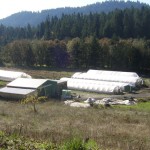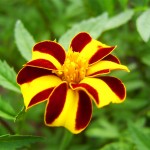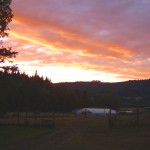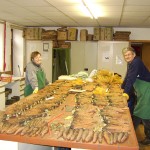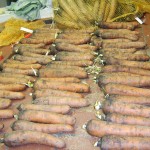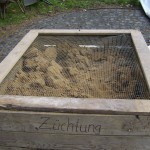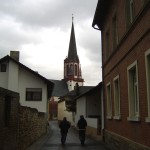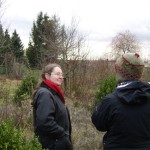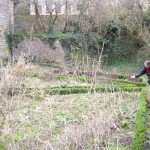Originally arranged 8/06 by Andrew Still and updated 7/07 with small update 8/14.
Introduction
Brassica napus
It is hard to convince everybody of this fact, but kale is the swellest of vegetables and Brassica napus is the best of the best. The Russo-Siberian Kales mostly have come out of Northern Europe and Northern Asia, though in the past century they have been shuffled back and forth across the globe like many of our cultivated plant species. Red Russian and Siberian are the two most well known varieties in the United States, however many others have been developed from these lines.
These kales are typically more tender and have a milder flavor than the European “oleracea” kales and are therefore the young leaves are better for salad use. They are always superb as a cooked vegetable when the leaves have grown to full size. Most Varieties are great for used for their springtime sprouts (similar to broccoli raab), although some varieties are specially bred for that use.
Napus kales are super hardy winter survivalists. They are hardy to at least 10°F once established and some sources claim them to be hardy to -10°F and maybe -20°F. Survival at these extra low temperatures may require a good mulch and/or snow cover. There are many factors known and unknown that can effect winter hardiness and there can be no real guarantee for how cold a crop can go. Wind can be an important factor in killing plants and a pattern of freeze thaw freeze thaw can also be detrimental. They Perform best in cool weather but many varieties of napus kales tolerate hot weather. It is widely known that the flavor of Russo-Siberian kale sweetens dramatically after first frost. It can be grown anywhere in the US and even in Alaska.
Being variable in its forms, Brassica napus is divided into three groups or subspecies. The Rutabaga (Swedes in England) is ssp. napobrassica or rapifera and are grown for grown for their swollen stems/roots that resemble turnips (B. rapa). Russo-Siberian Kales and Hanover Salad are ssp. pabularis or pabularia and are grown for their leaves that may resemble those of the European kales (B. oleracea). Winter rape and canola, colza in India, are grown for their edible leaves, livestock forage, or for the oil rich seed. All have large, flat leaves 12-20 in (30.5-50.8 cm) long and 8-15 in (20.3-38.1 cm) wide, stand 2-4 ft (0.6-1.2 m) when mature, have yellow, cross-shaped flowers with four petals and the small seed develops in sickle shaped pods.
Presently, the species Brassica napus is thought to have originated from a chance hybridization between Brassica rapa and Brassica oleracea. This cross probably happened in European gardens during the Middle Ages. The rutabaga, kale and rape may have all originated from separate chance hybridization between the diverse forms of B. napa and B. oleracea. For example, napus kale could have been derived from B. oleracea ssp. acephala (kale/collard) crossing with the B. napa ssp. chinensis (Asian mustard). The rutabaga could have been derived from B. oleracea ssp. acephala (kale/collard) crossing with the B. napa ssp. rapifera (turnip).
The red Russian type of kales may have a different story. Tim Peters of Peters Seed and Research did an experiment to retrace the evolution of B. napus. He first crossed a Chinese cabbage (B. rapa) with a European kale (B. oleracea). He did these crosses with a bud pollination technique, which he says “lets the two species have more time to get to know each other”. After the first cross the result was a beautiful Siberian kale (B. napus). then he crossed in black mustard (B. nigra). This resulted in the red Russian type (B. napus?) with its distinct color and leaf shapes. So some of the B. napus species are two way mix-ups and some are three way mix-ups. How wonderful! This throws a wrench of doubt into the machine of the probable genealogy of plants, such are the ways of science.
Classification Information for Brassica napus ssp. pabularia
Order Capparales
Family Brassicaceae (mustard family)
Genus Brassica (mustard genus)
Species Brassica napus (rape species)
Variety/Subspecies pabularia (Siberian kales) Continue reading
